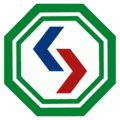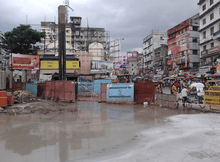Kolkata Metro Line 2
| Kolkata Metro Line 2 East West Metro ইস্ট ওয়েস্ট মেট্রো | |
|---|---|
 | |
| Overview | |
| Type | Rapid transit |
| System | Kolkata Metro |
| Status | Under Construction |
| Locale | Kolkata |
| Termini |
Howrah Maidan (west) Salt Lake Sector 5 (east) |
| Stations | 12 |
| Daily ridership | 4 lakhs or 0.47 million by 2015 (projected) |
| Website | KMRC |
| Operation | |
| Operator(s) | KMRC |
| Character | Elevated and Underground |
| Rolling stock | CAF [1] |
| Technical | |
| Line length |
14.67 kilometres (9.12 mi) Underground : 8.90 kilometres (5.53 mi) Elevated : 5.77 kilometres (3.59 mi) |
| Track gauge | 1,435 mm (4 ft 8 1⁄2 in) standard gauge |
| Electrification | 750 V DC[2] using third rail |
| Operating speed | 80 km/h (designed) |
Line 2, also known as East-West corridor of the Kolkata Metro is a rapid transit system under construction which will serve Kolkata, Salt Lake and Howrah in the Indian state of West Bengal underneath the Hooghly River. It would consist of 12 stations from Salt Lake Sector V in the east to Howrah Maidan in the west, of which 6 would be elevated and 6 would be underground, with a total distance of 14.67 km. The East-West Metro would be the first metro in India that would have an underwater stretch, under the Hooghly River. The tunnel is to pass 100 feet below the river bed.

History
The master plan had already identified the corridor way back in 1971. But the experience of India’s first metro and the success of the Delhi metro network contributed to the sanction of the East – West Metro corridor which will connect Howrah Railway Station with the Satellite City of Salt Lake underneath the Hooghly River. In January 2004, Pacific Consultant International Group conducted a feasibility study for the line. The report proposed the route and tubular structures under the Hooghly River.
A new organization was formed known as Kolkata Metro Rail Corporation Limited (KMRC) which will be executing the operations of this Line thus starting the physical construction in year of 2009.[3] Of KMRC's eight directors, four each are from the state and central governments. The cost is being shared between the state government (30 per cent), the Union Urban Development Ministry (25 per cent), and the Japan Bank for International Cooperation (JBIC) (45 per cent).[4] But as of 2011 most of the share of this project went to Indian Railways with Japan Bank for International Cooperation (JBIC). The project is estimated at a cost of ![]() 50 billion (US$790 million).[5]
50 billion (US$790 million).[5]
But due to some major set backs the project got delayed. These were mainly due to Land Acquisition, slum relocation and route alignment problems. The East-West Metro was originally slated to be operational by 2012, but is later pushed back to 2015. The first phase, a stretch of 9 km, is currently expected to be operational in September 2015 and the second phase, 6 km in length, will be operational by December 2016.
Infrastructure
Stations
All the stations in this line will be equipped with Platform Screen Doors to keep people away from the tracks.[6] Mott MacDonald is the detailed design consultant for all the elevated stations, whereas Lee Harris Pomeroy Architects have designed all the underground stations. Out of the 6 underground stations, 3 will be built by ITD Cementation, a part of Italian-Thai Development Public Company and the other 3 will be built by Afcons including the 520 meters underwater stretch. All the elevated stations will be built by Kolkata based Simplex Infrastructure ltd.[7][8]
Electrification & Signalling
The line will have two types of signalling equipment supplied by ANSALDO STS . One will feature cab signalling and continuous automatic train control with automatic train protection. The other signalling equipment will include an integrated system featuring fibre optic cable, SCADA, radios and a PA system. The line will also have a train information system, control telephones and a centralised clock system.
Operations
Unlike the north-south corridor, the east-west metro will run from 5 am to 11 pm at a frequency of 2.5 minutes during peak hours and 5 minutes during non-peak hours.[9]
Rolling stock
CAF in collaboration with Melco will supply 14 trains for this line.[10] The 14 rakes were acquired at a cost of approximately €110m[11] ![]() 6 billion (US$95 million).
Each rake will compose of 6 coaches having a capacity of 2068 people per train.[12] The maximum speed of the train will be 90 km/h. The first lot of trains will be manufactured in Spain & will be imported to Kolkata on November 2014. The next lot will be manufactured in India.
6 billion (US$95 million).
Each rake will compose of 6 coaches having a capacity of 2068 people per train.[12] The maximum speed of the train will be 90 km/h. The first lot of trains will be manufactured in Spain & will be imported to Kolkata on November 2014. The next lot will be manufactured in India.
See also
- Kolkata Metro
- List of Kolkata metro stations
- Kolkata Metro Rolling Stock
- List of rapid transit systems
- Kolkata tram
- Kolkata Lightrail
- Kolkata Monorail
- Kolkata Suburban Railway
References
- ↑ "In Spanish.".
- ↑
- ↑ "East-West Metro gets new boss". The Telegraph.
- ↑ "East-West Metro's route likely to change". Business Standard.
- ↑ http://www.thehindubusinessline.com/industry-and-economy/logistics/article3650126.ece?homepage=true&ref=wl_home
- ↑ "KMRC=2013-07-22".
- ↑ "Mott MacDonald is detailed design consultant on Salt Lake City Stations". Retrieved 2013-07-22.
- ↑ "Railway Technology". Retrieved 2013-07-22.
- ↑ "Kolkata East West Metro". Retrieved 2013-07-22.
- ↑
- ↑
- ↑
External links
| ||||||||||||||||||||||||||||||